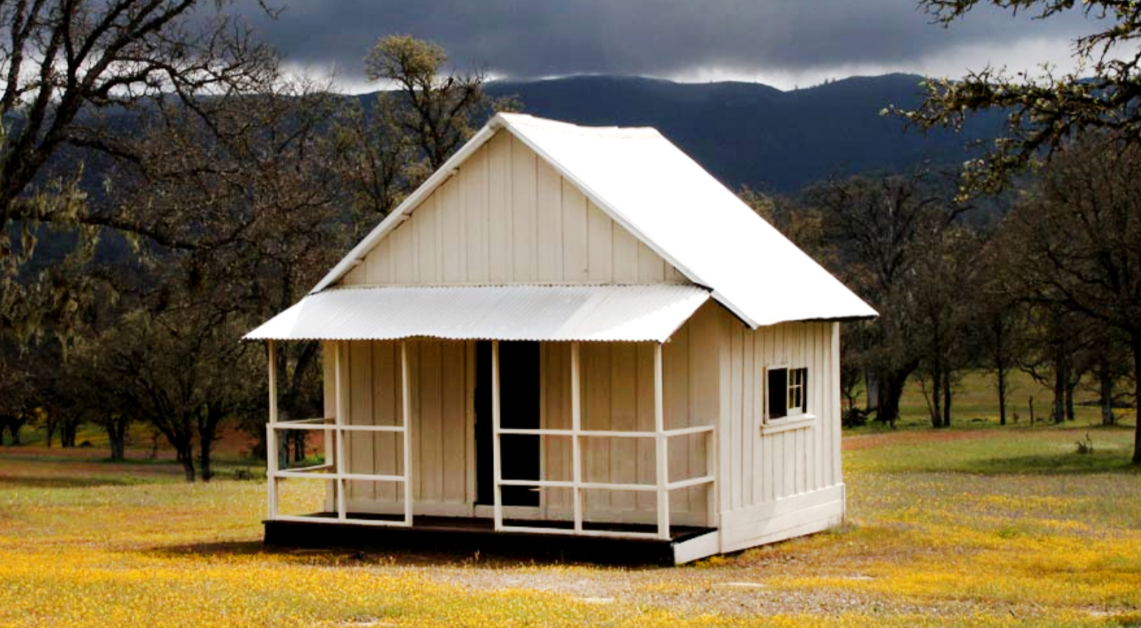Historical Overview Shanti Ashrama

While Swami Vivekananda was in America holding classes and delivering lectures, one of Swami Abhedananda’s students, Miss Minnie C. Boock, offered, as a gift for the work, a tract of land of 160 acres lying in the San Antonio Valley, eighteen miles southeast of Mt. Hamilton, California, the site of the well-known Lick Observatory. Swamiji accepted the offer in the name of the Ramakrishna Mission of Belur Math, the property to be held in trust as a peaceful retreat where those, seeking rest from the clamor of the world, could go for spiritual rejuvenation.
Situated at the head of the picturesque San Antonio Valley, in Santa Clara County, sparsely wooded with oaks and chaparral, with ranges of bush-covered hills on either side and the Sierra Nevada Mountains in the far distance, and removed from crowds and cities, Shanti Ashrama, as named by Swami Turiyananda who became its founder in August 1900, was an ideal spot for spiritual practice.
Swami Turiyananda, with eight students, traveled to the homestead, the sole building being an old log cabin. As time passed tents were pitched, a kitchen and screened dining room, a log cabin, several outhouses, and three canvas-walled cabins were erected, as well as a small meditation cabin, which stands to this day. Most importantly, a daily routine was established which blended spiritual life with practical life.
Gurudas, later known as Swami Atulananda, wrote of life at the ashrama with Swami Turiyananda: “To live with the swami was a constant joy and inspiration and it was an education, for one was learning all the time. And we all felt that spiritual help came through him. Sometimes gentle, sometimes the “roaring lion of Vedanta,” the swami was always fully awake. There was not a dull moment in the ashrama. It was a sweet life and it was surprising how soon newcomers imbibed the spirit of the place. There was no idleness — it was a life of external and internal activity. The swami was full of fire and the fire was communicated to the students. Enthusiastic and sincere, everyone tried his best to realize God.”
Swami Turiyananda returned to India in 1902, and Gurudas continued to live at the ashrama until 1906 when he himself went to India. When Swami Trigunatita, another disciple of Sri Ramakrishna, like Swami Vivekananda and Swami Turiyananda, arrived in San Francisco in 1903, he was very enthusiastic about the ashrama and for many years took groups of students there for monthlong retreats. The swami gave classes under a large, spreading oak tree, which came to be known as the “Om Tree.” The students were also inspired by occasional nightlong vigils around a fire at the top of a nearby hill, where the night was spent in prayer, chanting, and meditation.
During this time many further improvements were made on the property. Several additional cabins were built, as well as a large kitchen-dining hall and a barn. Lack of water has always been the greatest drawback of the ashrama. In the earliest years, water was hauled by the barrel, at seventy-five cents per barrel, from a distant source in the valley. Then, still in Swami Turiyananda’s time, spring was enlarged by blasting and a pool made in which one could bathe or wash one’s clothes. From there buckets of clear, cool water were carried by the students to the kitchen or the tents and cabins. In 1901 a pipe was laid, which brought running water to the heart of the ashrama, though the carrying of buckets was still needed. Several years later a well was dug, and Swami Trigunatita developed a water scheme which included a windmill and water tank, which were carted in from Livermore over the perilous road. This system finally provided enough water for drinking, cooking, and washing, though there was still not a sufficient amount for the garden.
During the 1920s, Swami Prakashananda regularly brought groups of students to the ashrama. And in later years, individuals occasionally took advantage of the ashrama atmosphere, but organized group retreats, as such, no longer occurred. A caretaker, Mr. Arthur Bryan, lived permanently on the property until August 1952, when a huge brush fire swept through the ashrama, and the surrounding properties, destroying the windmill, water tank, and many of the buildings including the caretaker’s cabin.
At this time the Society was devoting its available resources to developing a retreat at Olema, Marin County, which was more accessible to its members and friends and without such problems as a scarcity of water, as well as constructing a new temple, which would accommodate the increasing attendance at the Society’s services. Therefore, after the fire Shanti Ashrama was limited to occasional visits for necessary repairs to its fencing, etc., as well as infrequent day visits by a few members.
Suggestions for Further Reading
ATMAN ALONE ABIDES: CONVERSATIONS WITH SWAMI ATULANANDA
Swami Atulananda
Madras: Sri Rarnakrishna Math,1978
With the Swamis in America and India
Swami Atulananda
Swami Atulananda Mayavati: Advaita Ashrama, 1988
Early Days at Shanti Ashrama
Prabuddha Bharata,
August 1977 – June 1978
Madras: Sri Rarnakrishna Math,1978
Swami Trigunatita: His Life and Work
San Francisco: Vedanta Society of Northern California, 1977
Marie Louise Burke (Sister Gargi)
Swami Turiyananda: A Direct Disciple of Sri Ramakrishna
Madras: Sri Ramakrishna Math, 1963
Swami Ritajananda

 Streaming
Streaming
